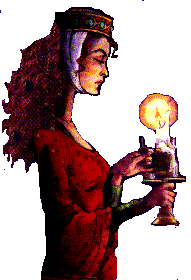
What Child Is This?
"What Child Is This?" is one of the most moving and beautiful of Victorian carols. It's history can be traced back farther than the days of the infamous Henry VIII. It dates from Elizabethan time, possibly even earlier.
The melody is the beautiful Greensleeves. This haunting melody, is often associated with guitar or harpsichord solos. As an ancient English folk song, there have been more than twenty different known lyrics associated with it throughout history and many more might have been lost. It was first published in 1652.
For much of its early life, the tune known as "Greensleeves" was associated with pubs as a popular drinking song. Although God is mentioned in a closing verse of the best-known
lyrics, nothing about the song closely resembled a religious piece; it was simply one of the era's most popular folk songs.
The song was first registered in 1850 to Richard Jones with lyrics that were neither religious nor respectable. Shakespeare mentions it by name in "The Merry Wives of Windsor" in which is it played while traitors are hanged.
In 1865 Englishman William Chatterton Dix wrote "The Manger Throne," three verses of which became "What Child Is This?" In the era while Dix was writing hymns and raising a family, Christmas was not the celebration it is today. Neither was it a season where many openly celebrated the birth of Christ. Conservative Christian churches forbade gift-giving, decorating, or even acknowledging the day. These Puritan groups feared that if set aside as a special day, Christmas would become a day of pagan rituals more than a very serious time of worship. In this context, it was unusual for Dix to feel moved to write about Christ's birth, since many hymn writers of the period ignored Christmas altogether.
The song's powerful words presented a unique view of the birth of Christ. While the baby was the focal point of the song, the viewpoint of the writer seemed to be that of an almost confused observer. Dix imagined visitors to the humble manger wondering who the child was that lay before them. He wove a story of a child's birth, life, death, and resurrection, but in each verse it was answered with a triumphant declaration the infant's divine nature.
Dix published "The Manger Thone" in England just as the U.S. Civil War was ending. The song was quickly imported from Britain to the United States. Dix, who died in 1898, lived long enough to see "The Manger Thone" become the much beloved Christmas carol "What Child Is This?"
Complete Lyrics:
What child is this, who, laid to rest
This, this is Christ the King,
Why lies He in such mean estate
This, this is Christ the King,
So bring Him incense, gold, and myrrh,
Raise, raise the song on high,
Definition of Laud:
Information gathered from several sources including:
Stories Behind The Best Loved Songs of Christmas, Ace Collins, 2001
The Spirit of Chirstmas: A History of Best-Loved Carols, Virginia Reynolds, 2000
Return to: Sean and Anna Annette Kasper's Christmas 2002 Newsletter
On Mary's lap, is sleeping?
Whom angels greet with anthems sweet,
While shepherds watch are keeping?
Whom shepherds guard and angels sing:
Haste, haste to bring him laud,
The Babe, the Son of Mary!
Where ox and ass are feeding?
Good Christian, fear for sinners here,
The silent Word is pleading.
Whom shepherds guard and angels sing:
Hail, Hail, the Word made flesh,
The Babe, the Son of Mary
Come peasant, king to own Him,
The King of kings, salvation brings,
Let loving hearts enthrone Him.
The Virgin sings her lullaby:
Joy, joy, for Christ is born,
The Babe, the Son of Mary!
Pronunciation: 'lod
Function: noun
Etymology: Middle English laudes (plural), from Medieval Latin, from Latin, plural of laud-, laus praise
Date: 14th century
1 : plural but singular or plural in construction often capitalized : an office of solemn praise to God forming with matins the first of the canonical hours
2 : PRAISE, ACCLAIM